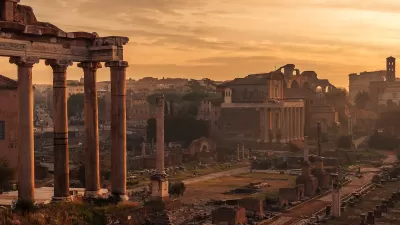The homes designed by architect John Lautner have appeared often in films, many times as characters themselves and many times associated with villains. Adam Baer examines what it is about Lautner's designs that inspire associations with evil.
Called “the world’s second-best architect” by his former employer Frank Lloyd Wright, and "a god" by Frank Gehry, it seems ironic that for an architect who "was first committed to building middle-class homes" and "lived in a workaday Hollywood apartment", his life's work is now mostly associated with notorious film villains and outcasts.
"Lautner homes—fluid, organic playgrounds for space and light, set in the elements—have been used in over a dozen movies, often as the homes of solitary men, most of them ne’er-do-wells," writes Baer. "The list of homes as film stars includes but is not limited to: the Elrod House in Palm Springs (fight scene, Diamonds Are Forever, Sean Connery vs. scantily clad Bond Girls in a roundtop room with a view of the Coachella Valley desert); the Garcia House, which literally looks like a glass eye built into the Hollywood Hills (and whose replica was dragged off a cliff by Mel Gibson in Lethal Weapon 2); the Jacobsen House, a hexagonal, steel-framed backdrop for a shootout between Paul Newman and James Garner in the 1998 crime mystery Twilight."
The most famous of Lautner's film stars is the Chemosphere, "an octagonal pod-like home with a 360° view, thrust above the hills on a single pole plunged deep into a steep, sloping lot," that's been a central character in films and television shows ranging from Brian de Palma’s Body Double to Charlie’s Angels to The Simpsons.
So what is it about his designs that inspire filmmakers and location scouts, and embody or converse with the often mischievous characters that inhabit them.
"Whether it’s the sculptural concrete, the walls of glass, or the surprising angles of steel and wood, the elements of Lautner’s homes appeal immediately to the human spirit," says Baer. "Lautner created spaces that invite us to be (or at least think) primal inside them, and therefore, in some sense, to act free, even play. His homes represent an independent, less systematic approach to modernism—honoring modernism more intrinsically than the homes of his forebears by following the contours of the earth as opposed to the linear blueprints of the more strict International Style."
"Despite their use in film, they evoke nothing nefarious; if anything, they project an exuberance for life, a dialogue with nature. Quite simply, they encourage imagination."
FULL STORY: If You Were Cool, Rich, or Bad Enough to Live Here, You'd Be Home

Maui's Vacation Rental Debate Turns Ugly
Verbal attacks, misinformation campaigns and fistfights plague a high-stakes debate to convert thousands of vacation rentals into long-term housing.

Planetizen Federal Action Tracker
A weekly monitor of how Trump’s orders and actions are impacting planners and planning in America.

San Francisco Suspends Traffic Calming Amidst Record Deaths
Citing “a challenging fiscal landscape,” the city will cease the program on the heels of 42 traffic deaths, including 24 pedestrians.

Defunct Pittsburgh Power Plant to Become Residential Tower
A decommissioned steam heat plant will be redeveloped into almost 100 affordable housing units.

Trump Prompts Restructuring of Transportation Research Board in “Unprecedented Overreach”
The TRB has eliminated more than half of its committees including those focused on climate, equity, and cities.

Amtrak Rolls Out New Orleans to Alabama “Mardi Gras” Train
The new service will operate morning and evening departures between Mobile and New Orleans.
Urban Design for Planners 1: Software Tools
This six-course series explores essential urban design concepts using open source software and equips planners with the tools they need to participate fully in the urban design process.
Planning for Universal Design
Learn the tools for implementing Universal Design in planning regulations.
Heyer Gruel & Associates PA
JM Goldson LLC
Custer County Colorado
City of Camden Redevelopment Agency
City of Astoria
Transportation Research & Education Center (TREC) at Portland State University
Jefferson Parish Government
Camden Redevelopment Agency
City of Claremont




























